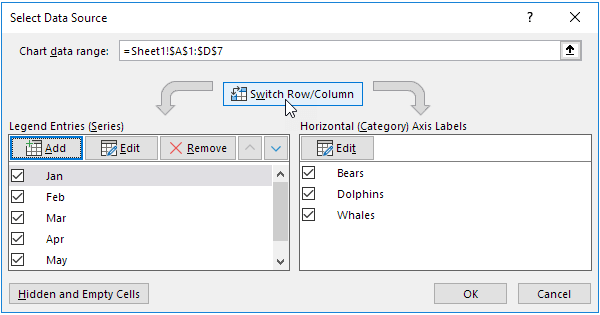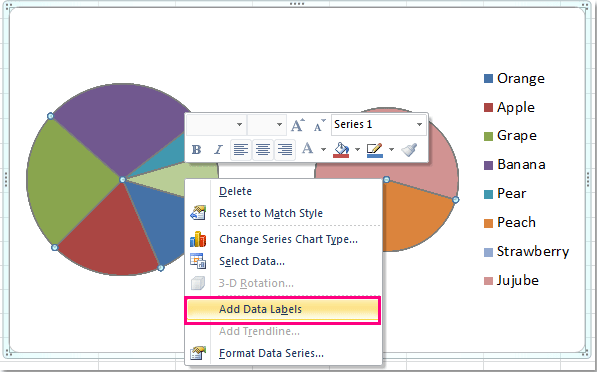

- #Select data for charts in excel mac how to#
- #Select data for charts in excel mac mac os x#
- #Select data for charts in excel mac manual#
- #Select data for charts in excel mac windows 7#
- #Select data for charts in excel mac series#
Under Error amount, click Custom, and then click Specify Value. It’s the third icon (3 bars of differing heights) at the top of the panel. Click the bar chart icon in the right panel.

Highlight the data that you want to graph, as shown in Fig. That is why I was so excited to upgrade: I was tired of painfully slow applications with strange compatibility issues (like Word's notebook view crashing when I stopped the audio recordings sometimes).
#Select data for charts in excel mac windows 7#
#Select data for charts in excel mac series#
Easy Project Management using Microsoft Excel (Series) This is the second part in a series on Project Management using Microsoft Excel.
#Select data for charts in excel mac how to#
And again: how to solve this problem about x-axis labes in bar chart? Take all formulas to the clipboard by pressing Ctrl+C on your keyboard. On the Chart Design tab of the Ribbon click the Add Chart Element Button 3.

I love all things related to brains and to design, and this blog has a lot to do with both. Right-click the existing chart, and click Select Data from the context menu. Click the arrow next to Error Bars and then click More Options… On the last tab of the Format Error Bars pane, under Error Amount, select Custom and click the Specify Value button. Double-click the file on your computer to open it in Excel. Open the spreadsheet that contains your chart. When you make Excel charts in Office 2011 for Mac, you find a brand-new set of Chart tabs on the Ribbon that guide you with the latest Microsoft charting technology. On the Chart Design tab, click Add Chart Element, and then click More Error Bars Options. Tip: Sometimes your data isn’t arranged in Excel in a way that lets you create the type of chart you want. Once you have calculated the mean for the -195 standardard deviation values for all of the temperatures. Hang tight for 30 secs while we redirect you. in comparison to some of the others (as much as 30 times). To read the introduction click here.You should also check out the follow-up article “5 bonus ideas that will make your Project Timeline Template even more useful” which you can find by clicking here. In the Format Error Bars pane, on the Error Bar Options tab, under Error Amount, click Custom, and then click Specify Value. In the Bars represent box choose either confidence interval or standard error. Select variables or groups the same way you would for a regular graph. Select "Simple" and either "summaries for groups of cases" (between-subjects) or "summaries of separate variables" (within-subjects) 3. Create the error bars by choosing: Graphs - Error Bar.
#Select data for charts in excel mac mac os x#
To do this, select cell A2 and type Order ID.MacBook Pro, Mac OS X (10.6.4), n/a Posted on 12:56 PM Reply I have this question too (201) I have this question too Me too (201) Me too 1. Your pivot table should now display the total quantity for each Order ID as follows:įinally, we want the title in cell A2 to show as "Order ID" instead of "Row Labels". Next under the Values box, click on the "Sum of Order ID" and drag it to the Row Labels box. In this example, we've selected the checkboxes next to the Order ID and Quantity fields. In the PivotTable Builder window, choose the fields to add to the report. Your pivot table should now appear as follows: In this example, we clicked on the "Existing worksheet" option and set the location to Sheet2!$A$1. Next, select where you wish to place the PivotTable. In this example, we've chosen cells A1 to D13 in Sheet1. Select the range of data for the pivot table and click on the OK button.
#Select data for charts in excel mac manual#
Click on the PivotTable button and select Create Manual PivotTable from the popup menu.Ī Create PivotTable window should appear. Next, select the Data tab from the toolbar at the top of the screen. In this example, we've selected cell A1 on Sheet2. Highlight the cell where you'd like to see the pivot table.

Question: How do I create a pivot table in Microsoft Excel 2011 for Mac?Īnswer: In this example, the data for the pivot table resides on Sheet1.


 0 kommentar(er)
0 kommentar(er)
